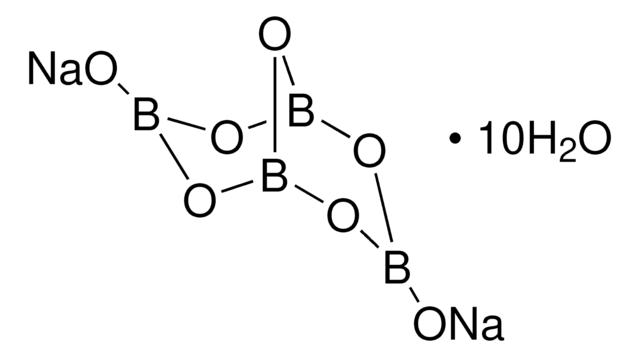15663
Boric acid
BioUltra, for molecular biology, ≥99.5% (T)
About This Item
Polecane produkty
klasa czystości
for molecular biology
Poziom jakości
ciśnienie pary
2.6 mmHg ( 20 °C)
linia produktu
BioUltra
Próba
≥99.5% (T)
Postać
powder or crystals
metody
DNA purification: suitable
RNA purification: suitable
zanieczyszczenia
DNases, none detected
RNases, none detected
insoluble matter, passes filter test
phosphatases, none detected
proteases, none detected
<0.05% non-volatile substances in MeOH/HCl
strata
≤0.5% loss on drying, 20 °C (HV)
pH
3.6-4.4 (25 °C, saturated solution in H2O)
mp
160 °C (dec.) (lit.)
rozpuszczalność
H2O: 1 M, clear, colorless (hot)
gęstość
1.49 g/cm3 at 23 °C
ślady anionów
chloride (Cl-): ≤5 mg/kg
phosphate (PO43-): ≤5 mg/kg
sulfate (SO42-): ≤5 mg/kg
ślady kationów
Al: ≤5 mg/kg
As: ≤0.5 mg/kg
Ba: ≤5 mg/kg
Bi: ≤5 mg/kg
Ca: ≤10 mg/kg
Cd: ≤5 mg/kg
Co: ≤5 mg/kg
Cr: ≤5 mg/kg
Cu: ≤5 mg/kg
Fe: ≤5 mg/kg
K: ≤50 mg/kg
Li: ≤5 mg/kg
Mg: ≤5 mg/kg
Mn: ≤5 mg/kg
Mo: ≤5 mg/kg
Na: ≤50 mg/kg
Ni: ≤5 mg/kg
Pb: ≤5 mg/kg
Sr: ≤5 mg/kg
Zn: ≤5 mg/kg
ciąg SMILES
OB(O)O
λ
1 M in H2O
absorpcja UV
λ: 260 nm Amax: 0.015
λ: 280 nm Amax: 0.010
InChI
1S/BH3O3/c2-1(3)4/h2-4H
Klucz InChI
KGBXLFKZBHKPEV-UHFFFAOYSA-N
Szukasz podobnych produktów? Odwiedź Przewodnik dotyczący porównywania produktów
Powiązane kategorie
Zastosowanie
Inne uwagi
Hasło ostrzegawcze
Danger
Zwroty wskazujące rodzaj zagrożenia
Zwroty wskazujące środki ostrożności
Klasyfikacja zagrożeń
Repr. 1B
Kod klasy składowania
6.1D - Non-combustible, acute toxic Cat.3 / toxic hazardous materials or hazardous materials causing chronic effects
Klasa zagrożenia wodnego (WGK)
WGK 1
Temperatura zapłonu (°F)
Not applicable
Temperatura zapłonu (°C)
Not applicable
Środki ochrony indywidualnej
Eyeshields, Gloves, type P3 (EN 143) respirator cartridges
Wykazy regulacyjne
Wykazy regulacyjne dotyczą głównie produktów chemicznych. Można w nich podawać ograniczoną liczbę informacji na temat produktów niechemicznych. Brak wpisu oznacza, że żaden ze składników nie znajduje się w wykazie. Użytkownik odpowiada za zagwarantowanie bezpiecznego i zgodnego z prawem stosowania produktu.
EU REACH SVHC Candidate List
EU REACH Annex XVII (Restriction List)
Certyfikaty analizy (CoA)
Poszukaj Certyfikaty analizy (CoA), wpisując numer partii/serii produktów. Numery serii i partii można znaleźć na etykiecie produktu po słowach „seria” lub „partia”.
Masz już ten produkt?
Dokumenty związane z niedawno zakupionymi produktami zostały zamieszczone w Bibliotece dokumentów.
Klienci oglądali również te produkty
Nasz zespół naukowców ma doświadczenie we wszystkich obszarach badań, w tym w naukach przyrodniczych, materiałoznawstwie, syntezie chemicznej, chromatografii, analityce i wielu innych dziedzinach.
Skontaktuj się z zespołem ds. pomocy technicznej





